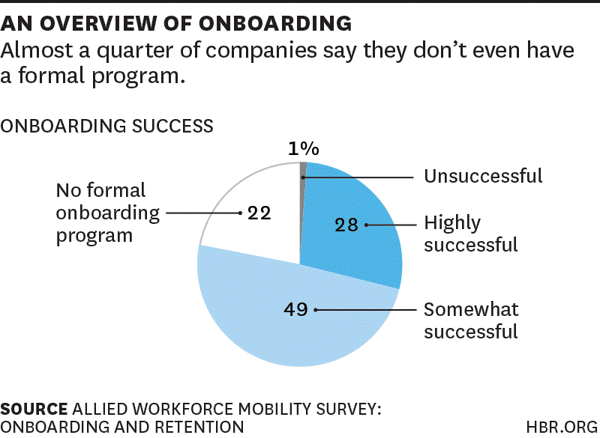There are a few different issues with employee onboarding that need to be addressed in an effort to ultimately reduce employee turnover. A poor onboarding experience means the context and connection the new employee has to the company is low, and that’s going to make them think about ultimately leaving sooner than they normally would. Employees do quit their jobs within six months more than you’d think — somewhere on the order of 30-50% in many studies — and that’s often tied directly to poor practices around onboarding new employees.
The first step: make sure you have an onboarding program
Many companies don’t even have a set program, or at least one they view as successful:

The second step: how you design it
Onboarding processes cannot be transactional. This person just went through a hiring process and probably had to come in for any number of stressful (for them) interviews. Now they’re a part of a new company. It’s almost the adult equivalent of starting at a new school. They want to feel connected to what’s happening.
Unfortunately at many jobs, onboarding new employees is heavily transactional. It’s HR forms, maybe lunch with the new boss, and walking around being introduced to people. There’s not often a deep connection back to the core work the organization does.
There can be, however. Look at this example from John Deere in India:
There’s a group at John Deere in India, where they face a really competitive labor market for engineers. On the first day, a new employee is met by a friend they had been corresponding with who shows up with a favorite beverage, and they walk to their cubicle. It’s already set up. In fact, the first email is from the CEO of John Deere, who talks about the legacy that we have, 175 years of innovation. The fact that we’re making products that make people food and give people shelter, so we’re doing important things for the world. He welcomes people to their first day. On the desk is a model of the first file that John Deere ever patented. It was a plow that you could pull behind your oxen or your horses that didn’t get caught up in root systems when you were plowing a field.
Or consider what happens to new employees at Facebook, one of the largest brands in the world:
Your first day at Facebook, you’ll have two emails in your inbox. One is a sort of generic, “Welcome to Facebook.” And the second one is, “Here’s a list of software bugs to fix.” On your first day, you’ll pull a version of Facebook’s code to your personal machine that’s your version of Facebook. You’re encouraged to go ahead and make changes, upgrades, improvements, whatever, from day one. You’re actually entrusted with that much authority. Facebook is literally a quarter of the internet everywhere in the world, except China. Here, some 22-year-old engineering grad has a version of it on his machine and he’s going to push a change to it today.
Both of those are much more connected experiences. You’re doing real work. You’re understanding the legacy of the brand. It’s a lot more than paperwork and quick meetings while standing near the desk of some new colleagues.
Smaller ways (and questions to ask) to improve employee onboarding
Realizing that not everyone is Facebook…
- Discuss actual job goals in the first 2-3 days: What would success look like in this job? What would failure look like? How will the success actually be measured?
- Ask one simple question: “What do you look like when you’re at your best?” Open with that. Let the new hire run down what makes him/her feel good, how they like to work, how they like to meet, how often they like feedback, what types of projects they enjoy, where and what they want to learn, etc. Make notes on these ideas. Bring them up. Utilize them.
- How does the company make money? This doesn’t need to be led by the CFO or anything, but every employee should understand how a company generates revenue. In the first 20 hours of employment, any new hire should have a good to very good understanding of how the company makes money.
- What are the cultural values? What do people value? What’s the mission statement?
- Who does what in your department and other departments? Understanding who does what makes your work life easier, and it makes it so that people step on each other’s tasks less.
- How does your job relate back to the bigger purpose of the department and company? Why are you essential here? Why are you needed?
- What should you achieve in the first week or month? Companies can try a “Passport” system for onboarding. There would be certain goals you need to achieve — meet someone from another department, go to a senior leadership meeting, attend a happy hour, etc.
- Think of onboarding as more than a 2-3 day experience: You don’t transition into a new relationship based on just the first two days. It evolves. So does your relationship back to jobs and companies. So shouldn’t onboarding be dynamic, as opposed to being static?
Effective onboarding is an important strategy to reduce employee turnover, and it can be the difference between employees who happen to do good work and employees who are motivated to do good work. With a few tweaks, your onboarding strategy can go from good to great – and your employee engagement rate will thank you.
Download The Advanced Guide to Onboarding HERE